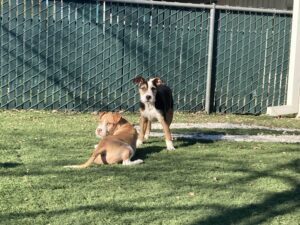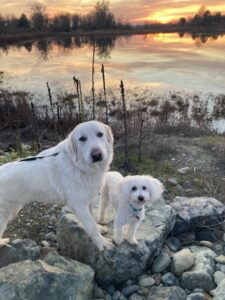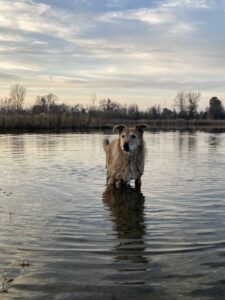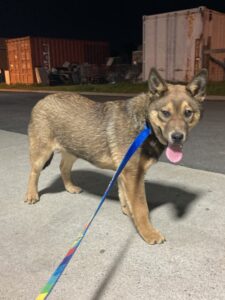My friend Leonora, owner of tiny Samson (my dog Woody’s BFF), is starting to search for a second dog. It’s been over a year since her last big dog died, and she’s just starting to look for just the right new family member. The candidate has to be gentle and dog-friendly enough to live with 4.8-pound Samson, whose legs are like chopsticks, so we’ve been frequenting our local shelter, which, sadly, is packed to the roof with dogs at the moment. Yikes.
Over the 14 years that I’ve been living in this town and volunteering for the shelter, I’ve earned the privilege of getting to visit and work with dogs when the building is closed to the public. So Leonora and I are able to wander through the adoption wing on weekends when she’s off work and take out any dogs we like.
I wanted to show her two puppies that I spotted. If my 14-year-old Otto was already gone, I would have adopted one of them myself. They both had irresistible scruffy faces like Otto and seemed like they were going to be a bit smaller than him, which I want for my next dog. I can’t bring a puppy home while we’re going through end of life stuff with him. I just can’t. But I was sorely tempted.
Leonora spent a long time with those puppies, and some time with a younger puppy. We’ve learned over the past few years that Samson can hold his own with very young puppies, effectively training them when they are young to not step on him or knock him over; if they do, he goes at them with a great show of ferocity, scaring but not hurting them. As they grow well past Samson’s size, they become increasingly careful with him! So getting a very young puppy might be the best way to raise a Samson-safe friend; older pups, in contrast, might not respect his ferocity, coming as it does in such a small package. For this reason, plus all the other work of raising a puppy, complete with housetraining and puppy kindergarten, Leonora is leaning away from the idea of adopting a puppy this time. Since she lives alone and works full time (and tiny

Samson gets to come to work with her, but a second dog could not), she’s not wild about the idea. And besides, puppies ALWAYS get adopted quickly; she’d like to help an older dog get out of the shelter.
I later learned that the two pups who tempted me so strongly were transferred to a shelter in the San Francisco Bay Area that has far fewer dogs. I’m so glad; they will get adopted in a hot minute down there.
Looking at adult dogs to adopt
We didn’t see just the right dog – but we saw one who needed help. There was a female Great Pyrenees, about 18 months old, pasted to the back of her kennel, who wouldn’t make eye contact with us. We looked at her cage card. She had been adopted two months prior, but was recently returned to the shelter because – I’m not making this up – shedding. No kidding!! A Pyrenees! There was one very hard, dry poop in her otherwise dry kennel; she was “holding it.” No wonder she looked so miserable.
I went inside her kennel, but she was petrified and wouldn’t approach me – wouldn’t even look at me. However, neither did she give me any aggressive signals. I scratched her chest for a moment, and she leaned a little closer to me. I slipped a leash over her head and she immediately moved to the kennel door; she knew this meant I would take her out.
Once outside and freed in a large run, the Pyr urinated for what seemed like several minutes, and then pooped several enormous poops. No wonder the poor baby looked so miserable inside!
This was Saturday morning on the Dr. Martin Luther King, Jr., holiday weekend, so the shelter was closed to the public for three days in a row. The staff would be cleaning and feeding, but the dogs don’t get outside on those days. I texted the shelter manager and asked if we could bring the Pyrenees home for the weekend, and happily she agreed. Much of the fencing on my property is only four feet tall, whereas Leonora has six-foot chain-link fences, so she agreed to hold the dog over the weekend. The dog’s name was supposedly “Pearl,” but she didn’t seem to recognize it over any other word, so we started calling her Delilah (you know, to go with Samson!).
She’s a strange girl, with some weird fears and apprehensions. She hops readily into the car, but then won’t get out. At first, we had to practically drag and push her into and out of the house; she didn’t like going through doorways. She chose to sleep in Leonora’s bathroom. The first night in the house, she didn’t move from the spot where we put a big blanket for her; the next night, she went into the bathroom and slept wedged between the toilet and the shower.
Come Tuesday morning, neither of us could stand the idea of taking the big, shedding dog back to the shelter. The shelter staff had already reached out to a Pyrenees rescue, and they are trying to find a foster or adoptive home for her, but for now, Leonora is fostering her and hoping to bring her more and more out of her shut-down behavioral shell.
Training another rehomed dog

Right when all that was going on, another friend of mine had adopted a dog – rehomed from Craigslist – but had to travel for much of the month of February. When she was making arrangements for the adoption, I told her I could dog-sit the new dog until she got back. So she had the dog for just over two weeks before I was going to dog-sit, and every day that passed, my friend was more convinced that she had adopted the wrong dog. This little Maltese/Poodle-mix (also about 18 months old, hmmm) is barky, not house-trained, has separation anxiety, and chased her elderly cat. And returning the dog was not an option. Oops! I told her not to make any hasty decisions, but to let me spend some time with the dog; we could more easily find the little cutie another home with a little training under her collar.
Sophie’s understanding of housetraining is fine, but she’ll sneak a pee indoors if you’re not paying attention. And her separation anxiety is not severe; she’s improving with my efforts to only slowly increase the duration of the minutes I leave her alone. I’ve been working a lot on name recognition and “leave it,” so whomever she ends up with will have solid tools to get her to turn away from whatever she is barking at and come back.
Five dogs go, six return
Given the exercise needs of both of these adolescent dogs, Leonora and I have been taking a lot of walks together. Given her mild separation anxiety, Sophie is terrific off-leash (I like to joke that the problem with separation-anxiety dogs is that you can’t leave them, but on the other hand, they won’t ever leave you!). She likes to run with my big dog, Woody, and looks extremely cute bounding through the tall grass in our local open spaces.
We don’t take Delilah off leash. The Pyrenees rescue group warned us that no matter how attached to you a Pyr seems to be, when given the opportunity, they tend to take off running and not look back. And since it’s still a challenge to get Delilah to so much as look at us when we say her name (she can do it well without distractions, but out in open spaces, forget it), we keep her on the long line.

Last weekend, Leonora and I took all five of our dogs (my three: Otto, Woody, and Sophie, and Leonora’s Samson and Delilah) for a short, slow, sniffing walk in the hour before sunset in a part of our local “wildlife area” where we don’t often walk. All of our dogs except Delilah were off-leash. When we were almost back to Leonora’s car, we heard a dog barking at us – though at first, we couldn’t tell where the barking was coming from. We have been out on the trail at this time of evening and had coyotes barking at and watching us, so Leonora scooped up tiny Samson and I quickly called Sophie to me and snapped her leash back on. A minute later, the barker revealed herself: a short, fat, (maybe) Cattle Dog-mix, came rushing out from underneath a tree, looking for all the world like a castaway on a desert island who just saw a boat on her beach. She was wary of all of our dogs, but came at me in a frantic fashion, “Oh my dog I am so glad to see you thank you thank you thank you I thought I was going to starve out here!”
Given that Leonora had her hands full with tiny Samson in her arms and giant Delilah on a leash, I told her to walk ahead so I could try to assess what was going on with the stray dog.
This wild enthusiasm had little Sophie freaked out – she wanted to get away from the whirling dervish – so I unclipped her leash and dropped a loop around the neck of the castaway, to try to contain her writhing and leaping about. Instantly she transformed into a wild horse at the end of a lasso: “What the heck? Are you trying to kill me? Help! Someone! Help! I’m dying!”
I hunkered down, food treats in hand. “Hey, buddy, it’s ok! Look! Food!” But the little dog was convinced she was about to be murdered. I slipped the leash off – and she reanimated immediately. “Thank you, thank you! Friend! Thank you!”
Given how portly she was, I wondered if she had pups under the tree; she was too close to the ground for me to see if she was nursing. I walked back over to the tree where she had been. The grass was all pressed down in that area, as if she had been hanging out there for some time, and there were torn-up fast food bags and wrappers strewn around. Had she raided garbage cans in the area and brought the bags back to her hiding spot? Or had she been abandoned there with a bag of food? There’s no telling.
Given that we already had a car FULL of dogs – small ones in the front seats with us, the giant one taking up the full back seat, and my two boys in the generously sized “way back” of Leonora’s SUV – I was worried about whether we could (or should even try to) bring the castaway with us in the car, especially given that she had not, apparently, had a leash on before. I decided not to make her come along with us, and instead, see if she would follow us the short distance back to the car, or go back to her tree. She not only followed, but hopped into the car pretty easily, hunkering down on the passenger side floor on my feet. Okay, well, we don’t have to worry about coyotes eating her, but where are we going to put her? I texted the shelter manager and asked if I could bring her in, and put her in one of the outdoor pens where local law-enforcement officers sometimes bring dogs they catch after hours. Thankfully, despite the crowding in the shelter already, she agreed.

At the shelter, I took pictures of the dog and put her in one of the outdoor holding pens with food, water, and a blanket. Back at home, I posted her picture on all the local “lost/found pet” sites I know and made a “found dog” flier to post back in the area where we found her the next day.
I had to scratch out the “female” part of my fliers the next morning when a shelter staffer texted me to let me know that my desert island dog was a neutered boy, not a girl. Whoops! He was fuzzy and low to the ground! But despite being neutered, no microchip. Argh!
I hear that in some parts of the country, there is a shortage of dogs to adopt? If that’s you, let me know! We’ve got way too many here.







“This was Saturday morning on the Dr. Martin Luther King, Jr., holiday weekend, so the shelter was closed to the public for three days in a row. The staff would be cleaning and feeding, but the dogs don’t get outside on those days.”
What now?! And they are supposed to urinate and defecate inside their kennels?
That’s exactly what I was thinking too. What are their reasons for those dogs to not get outside on days like that?
I’m surprised that you are surprised. How many municipal shelters have you been to? Very few (mostly small and rural) are able to provide outdoor runs to shelter wards, or to take them outside even once daily. In *most* shelters, dogs have to eliminate in their kennels.
Shelter workers, chime in?
Our rural county-run aged shelter is staffed by volunteers. The dogs are walked daily whether the shelter is open or not. Many of the dogs absolutely will not eliminate in their kennel.
I appreciate the compassion of the readers here who are horrified that some shelter dogs do not get a walk outside every day. It is painful to think about.
I hope those readers will find a local shelter that needs volunteer dog walkers. Action is the best antidote to despair.
Just curious – what is a “garage puppy”?
My own term for a pup from an accidental litter, or perhaps one meant for Craigslist sales, who has never been out of the garage he was born in, over-fed, under-exercised, and with zero exposure to the world (completely unsocialized).
Thank you!
Your friend might consider another smaller species to keep her small dog company. Perhaps a cat? Easy to find…will stay smaller than most dogs. Cheryl
Great idea!
So great of you guys to take the Great Pyr out of the shelter. She may actually be the perfect dog for little Sampson. We have had Great Pyrs and they are awesome dogs, good with all types of small animals (well, my Nuno liked to pluck our chickens alive…) and very gentle. They will „patrol their territory“ if allowed to roam and their their territory is as far as they can run/walk. My Pyrs never went after our cats nor our little dogs. Yes, they shed but they usually love being brished. The one big issue they all seem to have is that they are afraid of thunder and loud noises….i hope your friend keeps her.
She does behave around Samson. Only problem is she is not aware of him and will run him over. Woody always knows where Samson is. I now pick up Samson let her get zoomies out, then let Samson down.
As my younger sister used to say about my stepmother, “When I am reincarnated, I want to come back as one of your dogs.”
I can understand why you were tempted by those fuzzy faces – I would be too!!
I volunteer at a small local shelter in a rural community. Each of our kennels are equipped with doggy doors that lead to small outside areas for dogs to eliminate. We also have 4 long narrow runs behind the shelter building where the dogs are rotated throughout the day. I am there 3 days a week for 3-4 hours walking, socializing, playing with, & doing some basic training. On a good day I can get to 18 dogs. Shelters are always looking for volunteers, and we absolutely make a shelter dog’s day when they get to spend quality time with someone. Thank you Nancy for making shelter needs so visible!
Thanks, Lesley, for your volunteer time. My local shelter has 28 runs in the adoption wing, and 28 in the “isolation” side. Some runs house more than one dog; small dogs might be housed with one or more other small dogs. We have five outdoor runs where we can let dogs eliminate outside and stretch their legs for a bit. I’ve spent entire Saturdays trying to just the dogs on the adoption side out for a bit. It’s not as easy as filling each run sequentially: With some dogs, you have to stay with them in the run the whole time, or they will try to fence-fight or escape. And if you don’t pick up feces after each dog, it’s guaranteed the next one will run through it and jump on you! It’s incredibly time-consuming — and the shelter doesn’t have enough staff (or money to pay them) to spend this time. More volunteers would be great, but someone has to be there to supervise and support them (even the best volunteers sometimes have a dog get out and run around the shelter, or get something in their eye, or get knocked down by a big rowdy dog they probably shouldn’t have tried to get out…) and, again, on weekends, especially, the shelter is more lightly staffed. There is almost never enough help.
I have been volunteering with the dogs at our open admission shelter for 20+ hours a week for 16 years. We rarely can get ALL the dogs out for a meaningful walk on any given day, but we try! And most of them do get rotated out to the two potty yards once or twice. Otherwise they do have to eliminate in the back of their two-sided kennel. There is almost never enough help, as you said. We started a very intensive volunteer training program years ago, headed by a volunteer dog trainer, and we now have more skilled and experienced dog volunteers who can be trusted to work with the more challenging dogs— without supervision. It has made a huge difference, and now more dogs can get out every single day. I do appreciate SO much, Nancy, all your efforts to educate people about the realities of shelters. It truly takes a village to help all the animals in any given community, and I wish more people would consider stepping up to volunteer. It may well be the hardest and the most rewarding job anyone has ever had!
I am disappointed that you would recommend adopting two puppies together – it is seldom a good idea and can lead to many behavioral challenges. Two dogs adopted together often struggle to bond with their humans, become dependent on one another, and and over bond (often referred to as “super bonding”) with each other, all of which can lead to serious behavioral issues, including aggression and resource guarding. While it can occasionally work out, in my opinion it makes an almost impossible challenge for both humans and puppies. Each pup would have a far better chance of getting the one on one attention that is required to properly raise and train a puppy. By adopting them out individually they would be able to thrive, instead of just survive together.
I do NOT recommend adopting two puppies. The article said, “If my 14-year-old Otto was already gone, I would have adopted one of them myself.”
https://www.whole-dog-journal.com/lifestyle/are-two-pups-better-than-one/
https://www.whole-dog-journal.com/puppies/pre_puppy_prep/problems-associated-with-adopting-two-puppies-at-the-same-time/
https://www.whole-dog-journal.com/care/adopting-two-dogs-at-once-twice-as-nice/
The email excerpt from the article says both dogs and the article itself says one dog. The excerpt confused me since I’ve read your articles about adopting littermates. Reading the online article showed it was probably an editing error in the email.
I have twice found myself with sibling dogs. This was years ago when it was extremely hard to find a home for any large, adult dog found. It worked out fine both times. One of the dogs lived to be 17–a blessing for a 45 LB dog. I did lots, and lots, of training. I am guessing, but I think the fact that both sets of siblings were quite young and I had 6 other dogs helped.
You guys are so wonderful!!! Thank you for loving dogs the way you do!!! Your “desert island” dog is stunningly beautiful. Wish I could have 5 I’d steal him!!!
Nancy, I so wish I had the dog skills and insights that you have, so that I could be successful evaluating and training and generally truly HELPING. I adore them all and I’m just a total sucker/softy, without the skills to assess their personalities. I’m on my second toy-sized dog who I totally indulge. My dogs’ Samson-esque stature has meant I can pick them up to resolve most any issue and to keep them safe — and has made it easy to avoid training any skills! I have a deep fear of the heartbreak of volunteering at a shelter, more so now because I live in Georgia, which overflows with unwanted dogs. Until 2020 I was in the reassuring dog-care bubble of the Bay Area, where as you pointed out the numbers are so much smaller (although my current little man is a chihuahua from the Oakland shelter). BUT you are inspiring me to be brave enough to volunteer!
Nancy, I am so moved by and appreciate the way you step up to what is needed when you encounter a dog in distress, be it one that has an owner or a stray. Your story here inspired me to explore volunteer opportunities as my local shelter. I already donate $$ but it’s clear that the love and care needs for shelter pups are greater than ever. I adopted my chi-poo during COVID from the humane society and he’s the best little guy. So grateful for compassionate humans who take action.
My heart swells reading of your day’s experiences. In my 70s, lifelong big dog adopter(Goldens previous 30 yrs, singly), always learn from your writing. Now time to adopt a F. Golden-like adult dog <50#. Wish to continue Pet Therapy team. You wrote that your next dog will be smaller than Otto as well. I’m in s.e. FL till May.( snowbird from Morristown,NJ).New shelter here, PeggyAdams, intelligently designed, perhaps a model for good design. Humbly forward my assurances ( from vet, SGRR, friends) that I can provide excellent care and abundant love to my next dog. Any direction or resource would be treasured.Thank you for all you do🐾🐾❤️
Our adopted lab-pyr also can not be trusted off leash as we live on a guest ranch with horses cows , and many guests which must be greeted calmly never mind bears , MT lions which must be avoided. We love the big friendly galote
What I am finding through many of my searches for a companion dog for my giant breed is that too many of the dogs that appear to be a good match for my guy must also be the only dog or pet in the home. I’m not sure if this is a side effect of the over adoption and purchasing of dogs during the height of the pandemic by novice pet owners or an issue that was present before I began my search nearly a year ago. At any point, it is a disturbing because if the dog has issues with sharing a home or person with another pet, how does the dog react when out in public?
On another topic mentioned above, adopting two pups together does not always result in a negative outcome. Much depends on the training and knowledge of the human. I remember being told by the local shelter staff that the young female my late husband wanted to adopt would not be a good match the female (mine). When I inquired as to why, the staff person told me that from her experience two females would not get along and would tend to fight. Not deterred, I asked if I could bring my Amber for a meet and greet with the other dog. The staff person checked with the manager and a date and time were set. While I brought Amber into one of the outdoor runs, a staff member brought the other female into the adjacent run. The girls sniffed each other through the fencing and tags wagged – no snares, no hesitations, no fears. It was then decided to bring the female into the run with Amber but be ready for a hasty intervention if needed. To the staffs utter amazement, the two girls greeted each other like long lost relatives and from that moment the were the BFF.
Sometimes, it just takes a different attitude or approach to enlighten and change a preconceived opinion or conviction.
I work in rescue and have never had a problem adopting same sex dogs, 2 females or 2 males, into the same household. What is being discussed above about two puppies into the same household is littermate syndrome. 2 dogs from the same litter or different litters of the same age going into a home at the same time can and often does cause many, many problems. While many times it starts off perfectly, between 1-2 years of age trouble starts to show and often the family is left with the decision to rehome one of the dogs because the dogs can no longer be around each other safely.
Both Diana pawPrints and Freyja Grey came from the Hesperia Animal Shelter. Diana with her Mom and littermates before her eyes were open and Freyja at a bit over a year old. Diana and her family were rescued by a local rescue and fostered, which is how I came to adopt her after my Ramses died. Freyja I adopted direct and was a spur of the moment serendipitous accident. She had been picked up off the streets intact and was spayed a month before I adopted her. I suspect the reason the Hesperia shelter has so many strays is backyard breeding or as you refer to it, garage dogs. She is a Husky mix so possibly someone is still breeding Huskies because of Disney’s movie Togo. She actually looks like Togo as she is agouti. She was adopted twice and returned twice, the second time within 24 hours, for destructive behavior so she was “red carded.” That is why I decided to drive the three hours to get her. I couldn’t bear the thought of her being euthanized because people left her alone all day. I’m retired so can stay home with her all day, plus she has Diana for company. After 10 days she settled down to the routine of the house. She is a wonderfully affectionate girl now that she has figured out she is in her forever home and will never go to a shelter again. She has no idea how lucky she is or how close she came.
Our local shelter may not have an OVERabundance of dogs but I do see the same four breeds a lot. German Shepherds, pit bull/staffie, Chihuahuas and poodles. With a lab mix thrown in for variety. Pit Bull/Staffies and Chihuahuas tend to be most of the dogs. I suspect backyard breeding in my area as well. Our central shelter is fairly new and run by the Humane Society but space is tight and I’m not sure how much free run time or training they get. I do know they have trainers on staff. Also that they are truly a no-kill shelter.
Locally, the Helen Woodward shelter out of the city will take in what I call emergency dogs, dogs that are flown in after a disaster to free up space in local shelters. They will get dogs after hurricanes, tornadoes, floods and fires. They have a great space with outdoor runs but it is a bit of a drive to go out to visit and they only display a limited number of their available animals on line.
Nancy, this may seem strange, but I’m a volunteer with Homeward Bound Golden Retriever Rescue in Elverta (just outside Sacramento), and these days–because there are so few Goldens being surrendered or even found in Shelters–we’re taking in just about any breed of dog. (In fact, we seem to be getting in quite a few Great Pyrs!) We have a huge ranch with on-site kennels, volunteers that walk each dog twice a day, a local vet who does our spay-and-neuter surgery (plus microchip), and a staff that will work with “problem dogs” so that they can be adopted. You might consider giving them a call at 916-655-1410; their website is http://www.homewardboundgoldens.org .
I’m familiar with Homeward Bound, they are awesome! I will definitely contact them tomorrow; I had no idea they needed more dogs! I’d be happy to transport some dogs their way!
Well, I wouldn’t say we “need” more dogs 😊…but we’ll take in any dog that needs to find a forever home!
Seattle
Never enough dogs to adopt out
Our local, rural shelter has an exercise plan, and they walk the dogs 3x a day. They also have outdoor covered kennels they use when the weather is nice. There is a large 6 foot grassy pen where, they can each run, play, and have socialization time. They have worked several years improving the small bare-bones, basic concrete block building they started with.
Not sure if we still have a shortage of dogs to adopt here or not, but worth a try. We also have many good rescues. Reach out to the Rochester, New York area. Our biggest/best shelter would be Lollypop Farm.